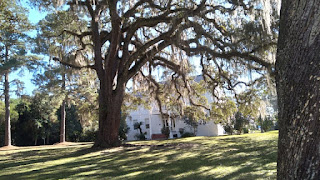 |
| The John Denham House, Italianate, 1874, a picture of Southern charm. |
My sister Andy and I took a road trip to Monticello, in Jefferson County, Florida. You can gather that the town's namesake is Jefferson's Monticello and all the history that surrounds it. It's just about 16 miles up the road from Andy's, straight East on Mahan Drive/Highway 90, under a Canopy of Live Oaks dripping with Spanish Moss.
When I'm in Florida, and I lived in St. Petersburg for ten years, it doesn't usually feel like the deep South, but it sure does this visit. I'm learning more about northern Florida, that Tallahassee was all plantations from very early on, and they extended to Monticello and beyond. I even recognized the names of the streets as we were driving east, many belonging to old Plantation masters, the land made bountiful by the free labor of slaves.
"The more you know, the more you see," I mused to Andy. She understood. The antebellum era, Reconstruction, Jim Crow have deep roots here. It's a story we need to understand, how it infused our history and culture. We recognize as well that the history is now overlaid by modernism, evolving cultural traditions and norms, incredible economic expansion, growing diversity, and changes to the land. .
We drove around the Court House, looking this way and that, getting the lay of the land. The 1890s red brick Opera House was to our right, and to our left a charming street of antique shops like Huckleberry's, a Wag the Tale humane society thrift shop, cafes and restaurants, a clothing boutique, commercial buildings and stores. We could see why the Monticello heritage district is on the National Register of Historic Places, its sites and beauty as old as the moss-covered oaks.
Off the main street a bit, we stopped by two lovely churches, one a white structure with a distinctive silver steeple reaching to an azure blue sky, the other a wooden structure with amazing embellishments, carvings and beautiful stained glass windows all around. I googled it when we got back to Andy's and learned it is a Carpenter Gothic architectural style, built in 1885. Fascinating. Next time I hope we can get into that church and see the windows up close. . .
 |
| The Perkins Opera House, 1890 |
We walked in and out of shops, bought a few Christmas gifts at Huckleberry's and Wag the Tail, and then stopped for lunch at The Brick House restaurant. We had freshly caught grouper and fried green tomatoes. Andy had fried pickles. It was down home Southern delicious.
We continued exploring after lunch, each of us pointing out houses and structures that got our attention. I loved the landscape, gently rolling hills (possibly old Indian mounds), the trees, the bright green leaves of camellias in pink and white.
We came upon two historic houses next to each other, both on the National Historic Register, according to the markers. The John Denham House, photo at top, is currently a Bed and Breakfast. Denham was a Scottish immigrant and a cotton merchant. His home is still perfectly lovely, settled comfortably under centuries-old Live Oaks. I couldn't take my eyes off of the octagonal cupola as I walked next door to the Palmer House. That was a mistake. I stepped on a sweet gum ball, I think it was, slightly twisted my ankle and went down, flat on my back. My cell phone went flying. I'm fine, but my phone's a mess.
I dusted off myself, and my pride, and continued on the short walk to the Palmer House, which sits silently on a large expanse of green lawn. It was built by Martin Palmer for his son John, the town's mortician. It's a simple Greek Revival architectural style built between 1850 and 1874. I couldn't help but think of the Civil War raging at the time, and the need for John Palmer's services. This place is rumored to be haunted by ghosts. It occurred to me that a ghost might be responsible for the fall I took, but Andy insists it was not a ghost but my admiring the scenery too much and paying attention too little. |
| Opera House entrance |
The entrance to the Opera House.
 |
| A delicious meal. |
 |
| Because my super selfie made us laugh! |











No comments:
Post a Comment